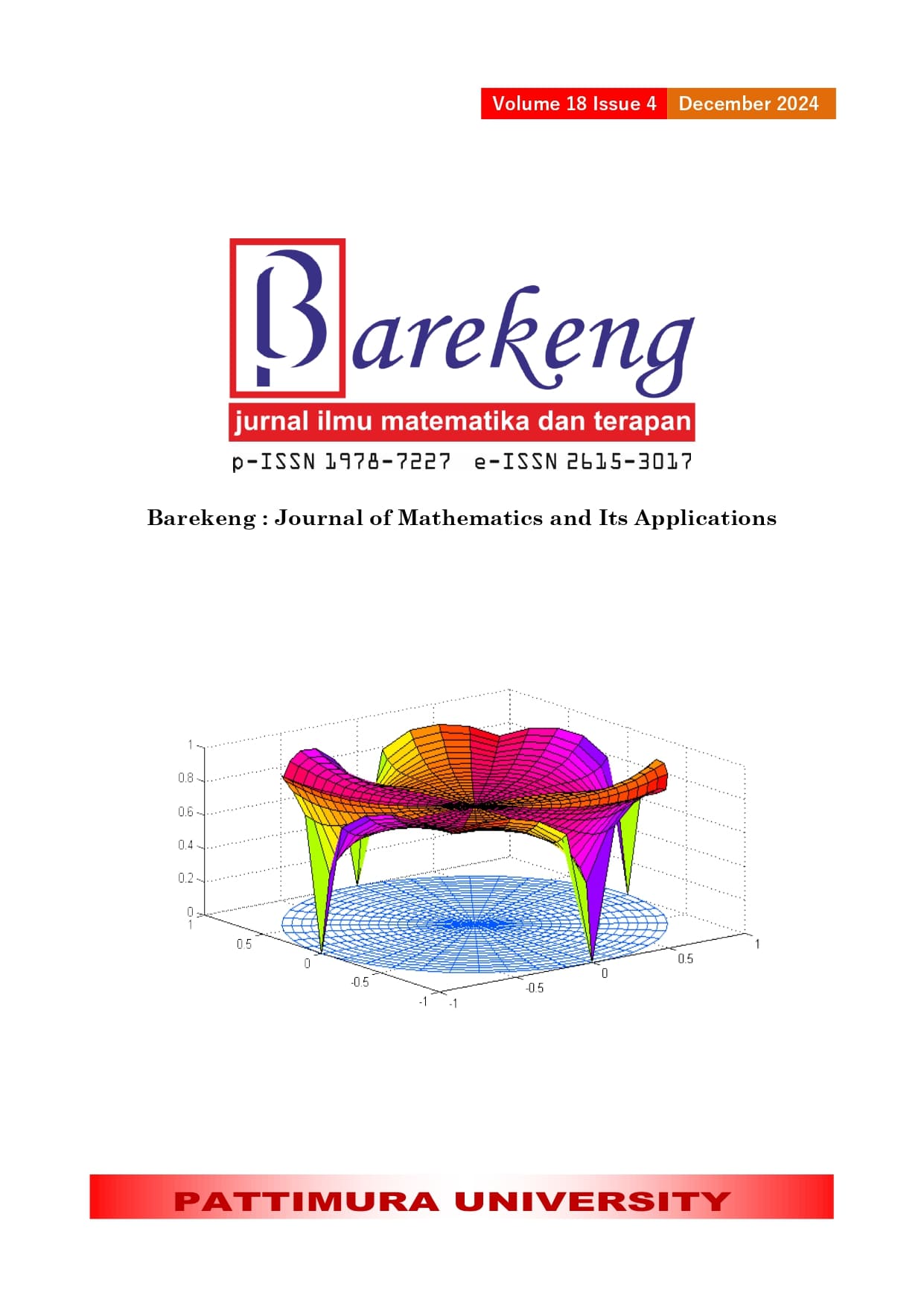CLUSTER MAPPING OF HOTSPOTS USING KERNEL DENSITY ESTIMATION IN WEST KALIMANTAN
Abstract
Forest and land fires pose a recurring concern every year in Indonesia, often taking place in West Kalimantan Province, particularly during the dry season. This study aims to use the Kernel Density Estimation (KDE) to categorize the data of the hotspots in the province of West Kalimantan according to their density and to map the cluster level of the fire risks in the region. The data utilized in this study are secondary data obtained from the images of the MODIS (Moderate Resolution Imaging Spectroradiometer) instrument, which are available on firms.modaps.eosdis.nasa.gov and provided by NASA. The data focuses on hotspots dispersed across West Kalimantan province during 2020. The variables examined in the study were the confidence level (≥80%) of forest and land fire hotspots, the distance from each point to the nearest river, and the distance from each point to the nearest road. The kernel density estimation method with a Gaussian kernel function yielded clustering results into three distinct groups according to their vulnerability levels. Low vulnerability areas comprise Cluster 1, which consists of 127 points or 50.97% of the total hotspots. Medium vulnerability areas belong to Cluster 2, which has 47 points or 30.32% of the total. Cluster 3 includes high vulnerability locations, consisting of 29 points or 18.71% of the total. The most susceptible areas to forest and land fires are located within the Ketapang regency.
Downloads
References
Kementerian Lingkungan Hidup dan Kehutanan, “Policy Brief Edisi 9 Th. 2020,” Jakarta: Ditjen Pengendalian Perubahan Iklim, 2020.
A. S. Thoha, B. H. Saharjo, R. Boer, and M. Ardiansyah, “Characteristics and causes of forest and land fires in Kapuas District, Central Kalimantan Province, Indonesia,” Biodiversitas, vol. 20, no. 1, pp. 110–117, Dec. 2018, doi: 10.13057/biodiv/d200113.
F. Guo, L. Zhang, S. Jin, M. Tigabu, Z. Su, and W. Wang, “Modeling Anthropogenic Fire Occurrence in the Boreal Forest of China Using Logistic Regression and Random Forests,” Forests, vol. 7, no. 12, p. 250, Oct. 2016.
A. M. Sabrina, “Strategi Pencegahan dan Penanggulangan Kebakaran Hutan dan Lahan,” Al-Mabsut: Jurnal Studi Islam dan Sosial, vol. 9, no. 1, pp. 119–130, 2015.
Giglio, Louis, MODIS Collection 6 Active Fire Product User’s Guide Revision B. University of Maryland.: Department of Geographical Sciences, 2018.
E.-S. M. M. Zahran and S. Shams, “Validation Of Forest Fire Hotspot Analysis In Gis Using Forest Fire Contributory Factors,” Systematic Reviews in Pharmacy, vol. 11, no. 12, pp. 249–255, 2020.
R. Rosdania, F. Agus, and A. H. Kridalaksana, “Sistem Informasi Geografi Batas Wilayah Kampus Universitas Mulawarman Menggunakan Google Maps API,” JIM, vol. 10, no. 1, p. 38, Jun. 2016.
M. J. Zaki and W. M. Jr, “Data Mining and Machine Learning: Fundamental Concepts and Algorithms,” Cambridge, UK: Cambridge University Press, 2020.
E. Setiawan, H. Murfi, and Y. Satria, “Analisis Penggunaan Metode Kernel Density Estimation pada Loss Distribution Approach untuk Risiko Operasional,” Jurnal Matematika Integratif, vol. 12, no. 1, 2016.
C. A. Nanda, A. L. Nugraha, and H. S. Firdaus, “Analisis Tingkat Daerah Rawan Kriminalitas Menggunakan Metode Kernel Density Di Wilayah Hukum Polrestabes Kota Semarang,” Jurnal Geodesi UNDIP, vol. 8, no. 4, Art. no. 4, Oct. 2019.
S. Węglarczyk, “Kernel density estimation and its application,” ITM Web Conf., vol. 23, p. 00037, 2018, doi: 10.1051/itmconf/20182300037.
A. Azzalini and G. Menardi, “Clustering via Nonparametric Density Estimation: The R Package pdfCluster,” J. Stat. Soft., vol. 57, no. 11, pp. 1–26, 2014.
E. Mapilata and K. Gandasasmita, “Analisis Daerah Rawan Kebakaran Hutan Dan Lahan Dalam Penataan Ruang Di Kota Palangka Raya, Provinsi Kalimantan Tengah,” Majalah Ilmiah Globe, vol. 15, no. 2, pp. 178–184, Sep. 2013.
P. Fitria, A. Jauhari, and F. Rianawati, “Analisis Tingkat Kerawanan Kebakaran Hutan dan Lahan Berbasis Penginderaan Jauh di Kecamatan Karang Intan,” JSS, vol. 4, no. 6, p. 1120, Dec. 2021.
B. W. Silverman, Density Estimation for Statistics and Data Analysis. London: Chapman dan Hall, 1986.
J. A. Saputra and E. Listyani, “Pemilihan Bandwidth pada Estimator Nadaraya-Watson dengan Tipe Kernel Gaussian pada Data Time Series,” Jurnal Pendidikan Matematika dan Sains, vol. 1, no. 1, pp. 1–7, 2016.
L. C. Matioli, S. R. Santos, M. Kleina, and E. A. Leite, “A new algorithm for clustering based on kernel density estimation,” Journal of Applied Statistics, vol. 45, no. 2, pp. 347–366, Jan. 2018.
Copyright (c) 2024 Cristy Framedia Cahyani, Dadan Kusnandar, Naomi Nessyana Debataraja, Shantika Martha

This work is licensed under a Creative Commons Attribution-ShareAlike 4.0 International License.
Authors who publish with this Journal agree to the following terms:
- Author retain copyright and grant the journal right of first publication with the work simultaneously licensed under a creative commons attribution license that allow others to share the work within an acknowledgement of the work’s authorship and initial publication of this journal.
- Authors are able to enter into separate, additional contractual arrangement for the non-exclusive distribution of the journal’s published version of the work (e.g. acknowledgement of its initial publication in this journal).
- Authors are permitted and encouraged to post their work online (e.g. in institutional repositories or on their websites) prior to and during the submission process, as it can lead to productive exchanges, as well as earlier and greater citation of published works.






1.gif)



